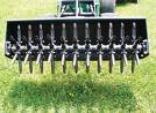

Benefits of Lawn Aeration

Aeration is the process of mechanically removing small plugs of thatch
and soil from the lawn to improve the flow of air, water, and nutrients.
Soil Compaction:
Most lawns, particularly heavily used ones, have compacted soil, which
restricts the movement of air and water to the root zone. Walking,
playing, and mowing are forms of traffic that compact soil and stress
lawns. Raindrops and sprinklers increase soil density by compacting soil
particles and reducing air spaces where roots may readily grow. Core
aeration helps heavily used lawns and lawns growing on compacted soils
by improving the depth and extent of turf grass rooting, allowing better
water uptake, and speeding up thatch breakdown.
Thatch Build-up:
Most lawns are subject to thatch build-up,
especially Bermuda lawns. Thatch accumulates
faster on Georgia's heavy clay soils and a layer
of more than 1/2" keeps air, light, and water
from getting to the root zone. Core aeration
breaks through dense thatch and opens up the
soil to permit free movement of water,
fertilizer, and air. Even the cores left on the top of the lawn after aeration
have their own thatch reducing mission. It takes about 14-21 days for the
cores to break down and dissolve back into the soil. Bacteria in the cores
reduces the thatch layer naturally by allowing the micro-bacterial
organisms to speed decomposition of remaining thatch.
Aeration Benefits:
Saves up to 50% on water!!!
Enhances water, fertilizer, and oxygen uptake and use.
Reduces water runoff and puddling.
Improves turf grass rooting.
Reduces soil compaction.
Enhances heat and drought stress tolerance.
Improves resiliency and cushioning.
Enhances thatch breakdown.
When should lawns be aerated?
Bermuda lawns can be aerated anytime during the growing season. (April
- June) To prevent crabgrass and other weeds, we suggest core aeration
combined with a pre-emergent fertilizer treatment before temperatures
are consistently in the 70's. It is best to aerate before you apply pre-
emergence herbicides, rather than after. Cool season grasses such as
Fescue should be aerated in the Fall - Winter.
Click Here For Free Estimate!
What to expect after core aeration:
Immediately after aeration, your lawn will be dotted with small plugs
approximately 3" in length. DO NOT REMOVE THE CORES FROM
YOUR LAWN. Raking up the cores/plugs reduces core aeration
effectiveness. Please allow a minimum of 5-7 days before mowing your
lawn after core aeration. Following normal watering schedules and the
intense effects of sun, these plugs will break apart and disappear into the
lawn. About 7-10 days after aeration, the aerification holes will begin to
be filled with white, actively growing roots. These are a sign that the turf
grass is responding to the additional oxygen, moisture and nutrients in
the soil from the core aeration process. After aeration, your lawn should
be able to go longer between waterings, without showing signs of stress.
With repeat aerations over time, your lawn will show enhanced heat and
drought stress tolerance. Lawns that are aerated regularly will be
healthier, more vigorous, easier to maintain and have fewer pest
problems than lawns that are not aerated.
and soil from the lawn to improve the flow of air, water, and nutrients.
Soil Compaction:
Most lawns, particularly heavily used ones, have compacted soil, which
restricts the movement of air and water to the root zone. Walking,
playing, and mowing are forms of traffic that compact soil and stress
lawns. Raindrops and sprinklers increase soil density by compacting soil
particles and reducing air spaces where roots may readily grow. Core
aeration helps heavily used lawns and lawns growing on compacted soils
by improving the depth and extent of turf grass rooting, allowing better
water uptake, and speeding up thatch breakdown.
Thatch Build-up:
Most lawns are subject to thatch build-up,
especially Bermuda lawns. Thatch accumulates
faster on Georgia's heavy clay soils and a layer
of more than 1/2" keeps air, light, and water
from getting to the root zone. Core aeration
breaks through dense thatch and opens up the
soil to permit free movement of water,
fertilizer, and air. Even the cores left on the top of the lawn after aeration
have their own thatch reducing mission. It takes about 14-21 days for the
cores to break down and dissolve back into the soil. Bacteria in the cores
reduces the thatch layer naturally by allowing the micro-bacterial
organisms to speed decomposition of remaining thatch.
Aeration Benefits:
Saves up to 50% on water!!!
Enhances water, fertilizer, and oxygen uptake and use.
Reduces water runoff and puddling.
Improves turf grass rooting.
Reduces soil compaction.
Enhances heat and drought stress tolerance.
Improves resiliency and cushioning.
Enhances thatch breakdown.
When should lawns be aerated?
Bermuda lawns can be aerated anytime during the growing season. (April
- June) To prevent crabgrass and other weeds, we suggest core aeration
combined with a pre-emergent fertilizer treatment before temperatures
are consistently in the 70's. It is best to aerate before you apply pre-
emergence herbicides, rather than after. Cool season grasses such as
Fescue should be aerated in the Fall - Winter.
Click Here For Free Estimate!
What to expect after core aeration:
Immediately after aeration, your lawn will be dotted with small plugs
approximately 3" in length. DO NOT REMOVE THE CORES FROM
YOUR LAWN. Raking up the cores/plugs reduces core aeration
effectiveness. Please allow a minimum of 5-7 days before mowing your
lawn after core aeration. Following normal watering schedules and the
intense effects of sun, these plugs will break apart and disappear into the
lawn. About 7-10 days after aeration, the aerification holes will begin to
be filled with white, actively growing roots. These are a sign that the turf
grass is responding to the additional oxygen, moisture and nutrients in
the soil from the core aeration process. After aeration, your lawn should
be able to go longer between waterings, without showing signs of stress.
With repeat aerations over time, your lawn will show enhanced heat and
drought stress tolerance. Lawns that are aerated regularly will be
healthier, more vigorous, easier to maintain and have fewer pest
problems than lawns that are not aerated.
| Evergreen Turf Management, Inc. Serving Your Area Since 1998 770-464-1649 Send mail to: mygreenturf@yahoo.com with questions or comments about this web site. |


EverGreen Turf (770) 464-1649
Management, Inc. "Serving the greater Atlanta area since 1998"
Management, Inc. "Serving the greater Atlanta area since 1998"